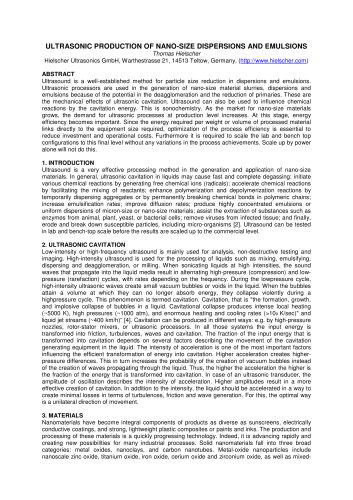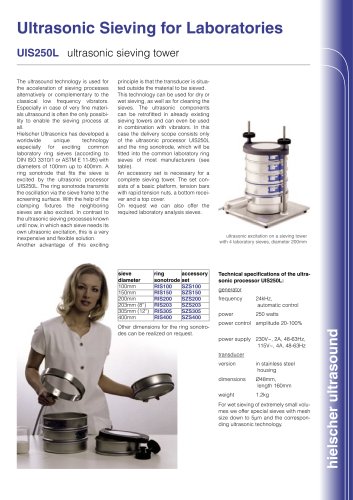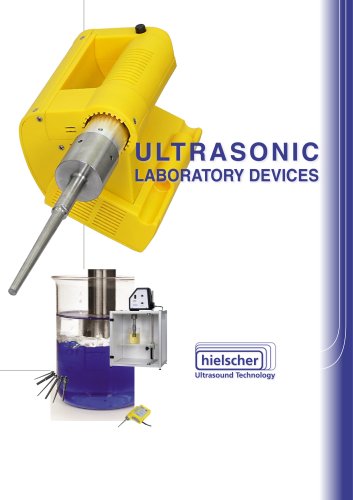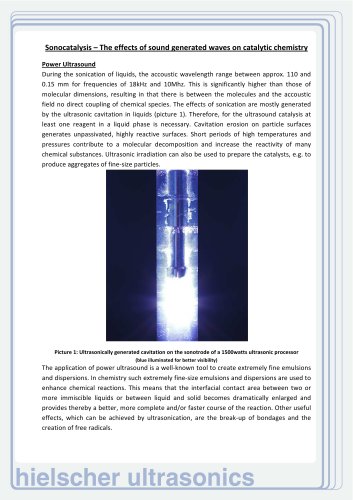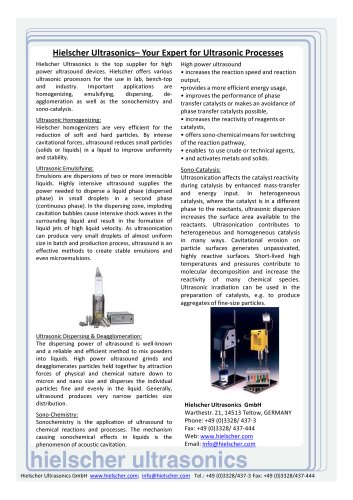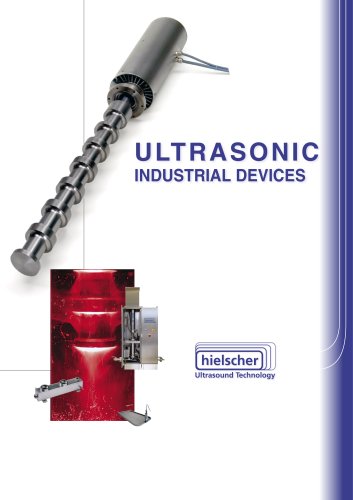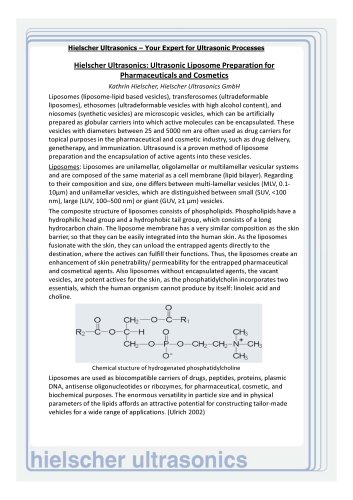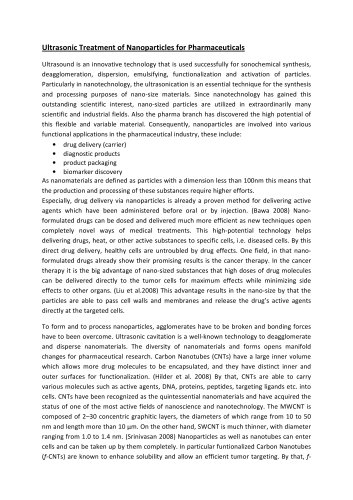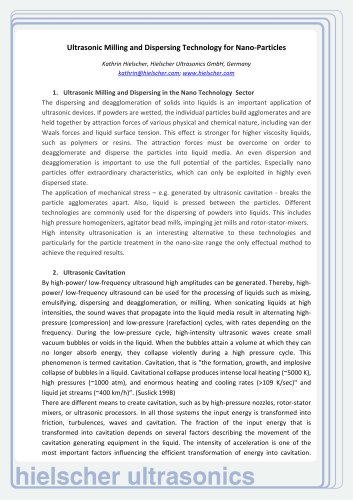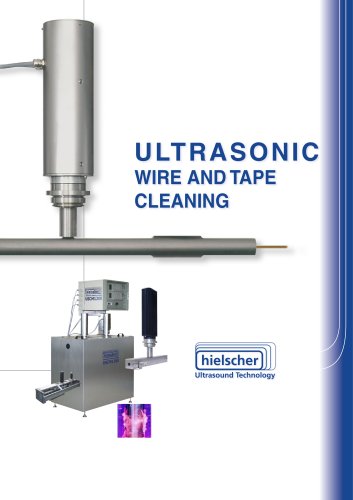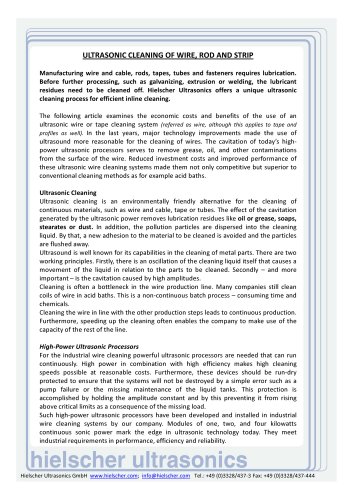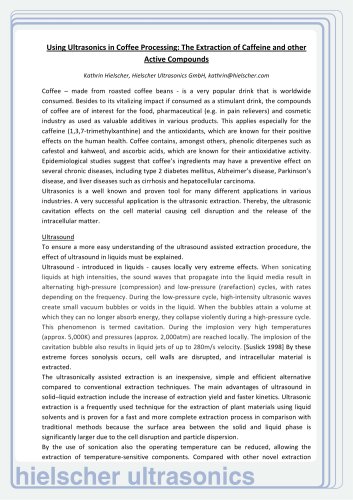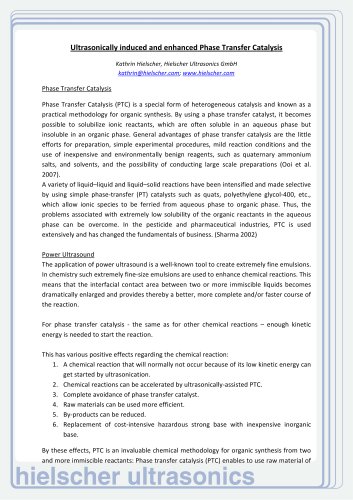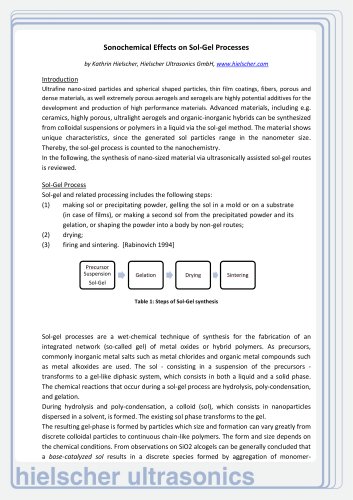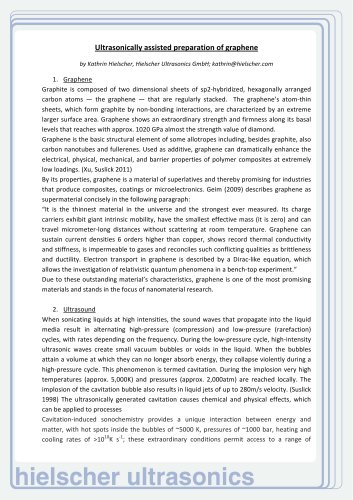Ultrasonic Production of Nano-Size Emulsions and Dispersions - Hielscher0 pages
ULTRASONIC PRODUCTION OF NANO-SIZE DISPERSIONS AND EMULSIONS
Thomas Hielscher
Hielscher Ultrasonics GmbH, Warthestrasse 21, 14513 Teltow, Germany, (http://www.hielscher.com)
ABSTRACT
Ultrasound is a well-established method for particle size reduction in dispersions and emulsions.
Ultrasonic processors are used in the generation of nano-size material slurries, dispersions and
emulsions because of the potential in the deagglomeration and the reduction of primaries. These are
the mechanical effects of ultrasonic cavitation. Ultrasound can also be used to influence chemical
reactions by the cavitation energy. This is sonochemistry. As the market for nano-size materials
grows, the demand for ultrasonic processes at production level increases. At this stage, energy
efficiency becomes important. Since the energy required per weight or volume of processed material
links directly to the equipment size required, optimization of the process efficiency is essential to
reduce investment and operational costs. Furthermore it is required to scale the lab and bench top
configurations to this final level without any variations in the process achievements. Scale up by power
alone will not do this.
1. INTRODUCTION
Ultrasound is a very effective processing method in the generation and application of nano-size
materials. In general, ultrasonic cavitation in liquids may cause fast and complete degassing: initiate
various chemical reactions by generating free chemical ions (radicals); accelerate chemical reactions
by facilitating the mixing of reactants; enhance polymerization and depolymerization reactions by
temporarily dispersing aggregates or by permanently breaking chemical bonds in polymeric chains;
increase emulsification rates; improve diffusion rates; produce highly concentrated emulsions or
uniform dispersions of micron-size or nano-size materials; assist the extraction of substances such as
enzymes from animal, plant, yeast, or bacterial cells; remove viruses from infected tissue; and finally,
erode and break down susceptible particles, including micro-organisms [2]. Ultrasound can be tested
in lab and bench-top scale before the results are scaled up to the commercial level.
2. ULTRASONIC CAVITATION
Low-intensity or high-frequency ultrasound is mainly used for analysis, non-destructive testing and
imaging. High-intensity ultrasound is used for the processing of liquids such as mixing, emulsifying,
dispersing and deagglomeration, or milling. When sonicating liquids at high intensities, the sound
waves that propagate into the liquid media result in alternating high-pressure (compression) and lowpressure (rarefaction) cycles, with rates depending on the frequency. During the lowpressure cycle,
high-intensity ultrasonic waves create small vacuum bubbles or voids in the liquid. When the bubbles
attain a volume at which they can no longer absorb energy, they collapse violently during a
highpressure cycle. This phenomenon is termed cavitation. Cavitation, that is "the formation, growth,
and implosive collapse of bubbles in a liquid. Cavitational collapse produces intense local heating
(~5000 K), high pressures (~1000 atm), and enormous heating and cooling rates (>109 K/sec)" and
liquid jet streams (~400 km/h)” [4]. Cavitation can be produced in different ways: e.g. by high-pressure
nozzles, rotor-stator mixers, or ultrasonic processors. In all those systems the input energy is
transformed into friction, turbulences, waves and cavitation. The fraction of the input energy that is
transformed into cavitation depends on several factors describing the movement of the cavitation
generating equipment in the liquid. The intensity of acceleration is one of the most important factors
influencing the efficient transformation of energy into cavitation. Higher acceleration creates higherpressure differences. This in turn increases the probability of the creation of vacuum bubbles instead
of the creation of waves propagating through the liquid. Thus, the higher the acceleration the higher is
the fraction of the energy that is transformed into cavitation. In case of an ultrasonic transducer, the
amplitude of oscillation describes the intensity of acceleration. Higher amplitudes result in a more
effective creation of cavitation. In addition to the intensity, the liquid should be accelerated in a way to
create minimal losses in terms of turbulences, friction and wave generation. For this, the optimal way
is a unilateral direction of movement.
3. MATERIALS
Nanomaterials have become integral components of products as diverse as sunscreens, electrically
conductive coatings, and strong, lightweight plastic composites or paints and inks. The production and
processing of these materials is a quickly progressing technology. Indeed, it is advancing rapidly and
creating new possibilities for many industrial processes. Solid nanomaterials fall into three broad
categories: metal oxides, nanoclays, and carbon nanotubes. Metal-oxide nanoparticles include
nanoscale zinc oxide, titanium oxide, iron oxide, cerium oxide and zirconium oxide, as well as mixed-

 عضویت
عضویت  ورود اعضا
ورود اعضا راهنمای خرید
راهنمای خرید







